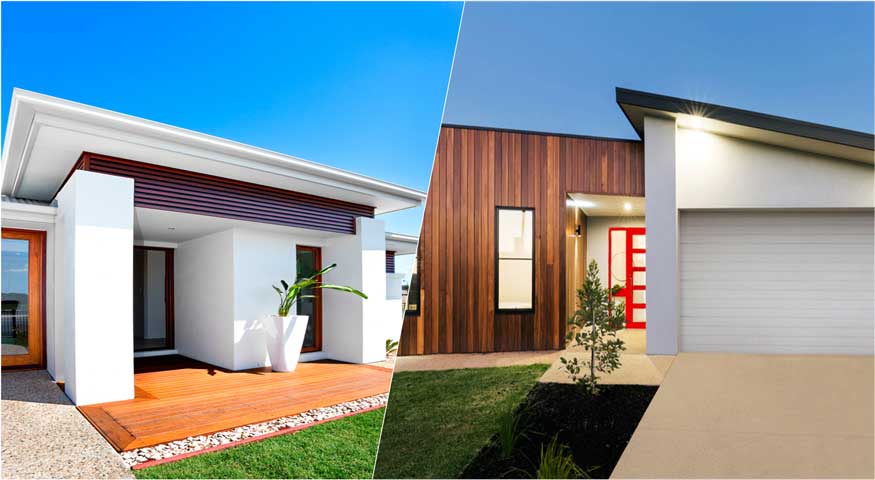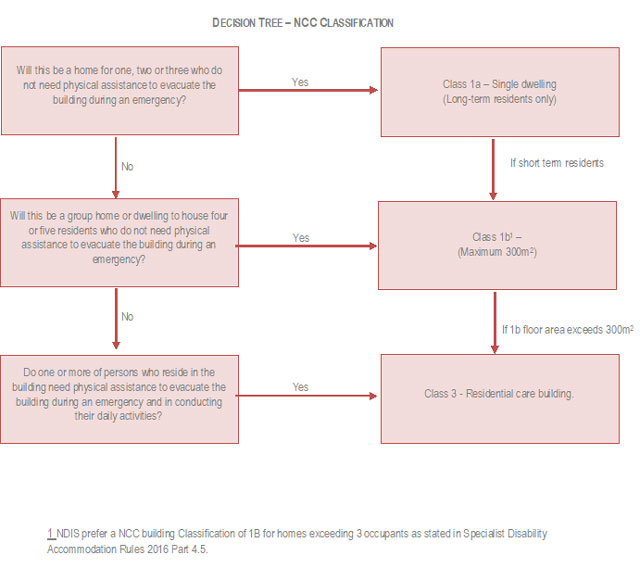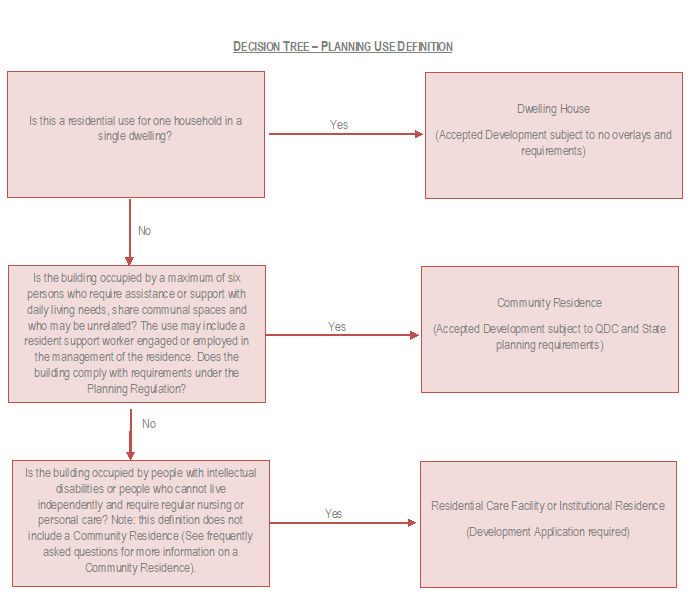National Disability Insurance Scheme and
Specialist Disability Accommodation
Further Information and FAQ
Building Classification under the NCC
NDIS and SDA
SDA certification is required at design stage and as-built stage from a qualified person to certify the relevant design category is achieved in accordance with the SDA Design Standard document.
All SDA buildings must be enrolled with the National Disability Insurance Association (NDIA) to receive funding. For further information regarding funding and dwelling enrolment contract the National Disability Insurance Association or a registered SDA Provider.
Planning Use Definition
This document contains important information for all Queensland stakeholders that are involved with the design and construction of specialist housing that will support occupants funded by the NDIS.
This information encompasses planning use definitions, building classifications under the National Construction Code (NCC), National Disability Insurance Scheme (NDIS) and Specialist Disability Accommodation (SDA).
When designing an SDA building it is crucial to understand the occupant characteristics and what the building will be used for. This will determine the building classification under the NCC and the planning use definition.

Frequently Asked Questions
What is a Community Residence?
A community residence is defined in the Planning Regulation as:
(a) means the use of premises for residential accommodation for—
(i) no more than—
(A) 6 children, if the accommodation is provided as part of a program or service under the Youth Justice Act 1992; or
(B) 6 persons who require assistance or support with daily living needs; and
(ii) no more than 1 support worker; and
(b) includes a building or structure that is reasonably associated with the use in paragraph (a).
When is a Community Residence not made assessable by a Planning Scheme?
Schedule 6 of the Planning Regulation states a planning scheme is prohibited from making a ‘Community Residence’ assessable where:
(a) the premises are included in a prescribed zone* under a local categorising instrument; and
(b) no more than 7 support workers attend the residence in a 24-hour period; and
(c) at least 2 car parks are provided on the premises for use by residents and visitors; and
(d) at least 1 of the car parks stated in paragraph (c) is suitable for persons with disabilities; and
(e) at least 1 car park is provided on the premises for use by support workers.
*Prescribed zone means:
any of the following zones stated:
(i) general residential zone, low density residential zone, low-medium density residential zone, medium density residential zone, high density residential zone, character residential zone or tourist accommodation zone;
(ii) centre zone, neighbourhood centre zone, local centre zone, district centre zone, major centre zone or principal centre zone;
(iii) community facilities zone;
(iv) environmental management and conservation zone;
(v) rural zone;
(vi) rural residential zone; or a zone, other than a zone that is of a substantially similar type to a zone mentioned in paragraph (a).
What are the NCC (National Construction Code) classifications?
Class 1a: One or more buildings, which together form a single dwelling including the following:
(a) A detached house.
(b) One of a group of two or more attached dwellings, each being a building, separated by a fire-resisting wall, including a row house, terrace house, town house or villa unit.
Class 1b: one or more buildings which together constitute—
(a) a boarding house, guest house, hostel or the like that—
(i) would ordinarily accommodate not more than 12 people; and
(ii) have a total area of all floors not more than 300 m2 (measured over the enclosing walls of the building or buildings
Class 3 building: a residential building providing long-term or transient accommodation for a number of unrelated persons, including the following:
(a) A boarding house, guest house, hostel, lodging house or backpacker accommodation.
(b) A residential part of a hotel or motel.
(c) A residential part of a school.
(d) Accommodation for the aged, children, or people with disability.
(e) A residential part of a health-care building which accommodates members of staff.
(f) A residential part of a detention centre.
(g) A residential care building*
*Residential care building means a Class 3 building where 10% or more residents require physical assistance in conducting their daily activities and to evacuate the building during an emergency.
How is a building classification determined under the NCC (National Construction Code)?
The classification of a building or part of a building is determined by the building certifier having regard to the purpose for which it is designed, constructed or adapted to be used.
Therefore, classification is a process for understanding risks in a building or part, according to its use. Each part of a building must be classified according to its purpose and comply with all the appropriate requirements for its classification.
It is possible for a single building to have parts with different classifications. Part of a building can also have more than one classification. Where there is any conflict between what requirements the part should comply with, the more stringent requirement applies.
Where it is unclear which classification should apply, appropriate authorities have the discretion to decide. They base their decision on an assessment of the building proposal.
They will look at what classification the building most closely resembles. They will also take into account the likely fire load, plus, the likely consequences of any risks to the safety, health and amenity of people using the building.
What is the relationship between the NDIS SDA Design Standard and the National Construction Code?
The NCC sets out the minimum construction requirements for all new building work in Australia.
The dwelling is required to comply with all applicable requirements of the NCC, including but not limited to waterproofing and termite protection measures. Apart from the spatial requirements as noted in this NDIS SDA Design Standard, where there is a conflict between the NCC and the NDIS SDA Design Standard, the NCC takes precedence.
What is the National Disability Insurance Scheme (NDIS)?
The NDIS funds a range of supports and services to people who have permanent and significant disability. Funding is provided directly to individuals on a reasonable and necessary basis.
In order to be considered reasonable and necessary, a support or service:
- Must be related to a participant’s disability
- Must not include day-to-day living costs not related to the disability support needs, such as groceries
- Shall represent value for money
- Must be likely to be effective and work for the participant, and
- Shall take into account support given to the participant by formal support services and a participant’s family, carers, informal network and the community.
What is Specialist Disability Accommodation (SDA)?
SDA is one of the supports that may be funded under the NDIS for some participants who have an extreme functional impairment or very high support needs.
SDA refers to accommodation for people who require specialist housing solutions, including to assist with the delivery of supports that cater to their extreme functional impairment or very high support needs. SDA does not refer to the support services, but the homes in which these are delivered. SDA may, for example, have specialist designs for people with very high needs or a location or features that make it feasible to provide complex or costly supports for independent living.
At the centre of the NDIS is the need to maximise the choice and control of the participant, and to promote opportunities for social and economic participation. Accordingly SDA should enhance self-determination and create the conditions required for participants to lead vibrant, safe and independent lives.
The Design Standards have been crafted with the intention of improving the lives of participants by assisting them to live in their own home that meets their individual needs and is situated in communities that facilitate social connections and a sense of belonging. The Design Standards focus is on providing a home environment that maximises the capacity of the individual to live as independently as possible incorporating personal support features within contemporary housing practice. Design to reflect an individual’s personality and interests is further encouraged. The diversity of accommodation provided should reflect the diversity of choice available to all members of the community.
SDA should be located on suitable parcels of land that support accessible dwelling and outdoor areas. The site should be in close proximity to public transport and amenity. The NDIS enables participants to choose from a variety of offerings as the SDA market matures, however location and access to amenity will be valued above all as it is in all real estate sectors.
What is the SDA Design Standard?
This document sets out the detailed design requirements that shall be incorporated into new SDA under the NDIS. This SDA Design Standard document is based on the four categories of SDA design which are set out in the SDA Rules, namely:
- Improved Liveability
- Robust
- Fully Accessible
- High Physical Support
From 1st July, 2021, all dwelling enrolment applications for SDA will be required to include a certificate from an Accredited SDA Assessor nominating the Design Category the dwelling to be enrolled satisfies based on the Design Standards established in this document.
How will the new SDA Design Standard be implemented?
The SDA Design Standard sets out the future requirements of well designed and built form of new SDA. The NDIA recognises that new build SDA projects will be underway during this time and acknowledgment of these is important, so as to not disrupt the increase to the supply of SDA.
This implementation plan sets out the timing and requirements in the lead up to the Design Standard taking full effect. The SDA Design Standard does not apply to dwellings seeking enrolment as Existing or Legacy SDA, noting that is expected that all existing and legacy SDA will have been enrolled by 1 July 2021.
When can the dwelling be SDA certified?
A dwelling can be certified to a particular Design Category at two stages:
1. Provisional – Design Certification of SDA dwelling
The dwelling design can be certified as compliant with the design requirements of a particular design category when the design has been submitted for building approval to a regulatory authority such as a council or a certifier.
The certification is called ‘Provisional’ as the dwelling has not been built at this stage. Only a built dwelling can get a Final certification suitable for NDIS enrolment.
2. Final-as-built Certification of SDA dwelling (Mandatory for SDA enrolment)
The dwelling shall be certified as a particular Design Category when the dwelling is built with the relevant features as listed in the Design requirements section of this SDA Design Standard document.
How is a dwelling enrolled with the NDIA?
All SDA dwellings must be enrolled with the NDIA. To enroll an SDA dwelling, registered providers complete the SDA Dwelling Enrolment Form and submit it to the NDIA. For more information on the definitions and terminology used in the Form please refer to the SDA Price Guide available on the SDA pricing and payments section of the website.
Dwelling Enrolment Forms must be submitted by an authorised representative of the registered provider and include a declaration that must be completed for the enrolment to be valid. Completed Dwelling Enrolment Forms must be emailed to: SDARegistration@ndis.gov.au
How is the building type determined under the NDIS
There are five SDA building types (which are described in further detail in the NDIS Price Guide):
(a) apartments, which are self-contained units occupying only part of a larger residential building. Apartments are typically classified as Class 2 under the NCC;
(b) duplexes, villas and townhouses, which are separate but semi-attached properties within a single land title or strata titled area. The dwellings will be separated from one or more adjoining dwellings by a fire-resisting wall (although fire resistance is not required for existing stock). These may also include ancillary dwellings that are located on the same parcel of land as another dwelling (such as standalone villas or ‘granny flats’). These types of buildings are typically classified as Class 1 (a) (i), 1 (a) (ii) or 3 under the NCC;
(c) houses, which are detached low-rise dwellings with garden or courtyard areas. Houses are typically classified as Class 1 (a) (i), 1 (b) (i) or 3 under the NCC;
(d) group homes, which are houses that are enrolled (or will be enrolled) to house four or five long-term residents. Group homes are typically classified as Class 1 (b) (i) or 3 under the NCC;
(e) larger dwellings, which are enrolled (or will be enrolled) to house more than five long-term residents (only funded in limited circumstances — see paragraphs 4.6, 4.10 and 4.11).
The appropriate building type for a participant is to be determined, out of the building types in paragraphs 4.5(a) – (d), having regard to:
(a) the participant’s preferences, if those preferences are established and align with the participant’s statement of goals and aspirations;
(b) the features of the building type;
(c) the support model that is most appropriate for the participant including immediately available or constant person to person supports (see paragraph 4.7);
(d) the participant’s support needs; and
(e) whether the building type would represent value for money in that the costs would be reasonable, relative to both the benefits achieved and the cost of alternatives.



